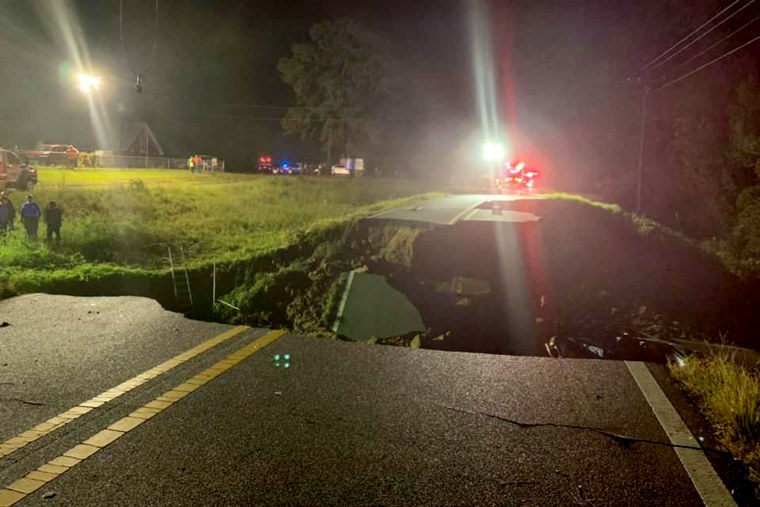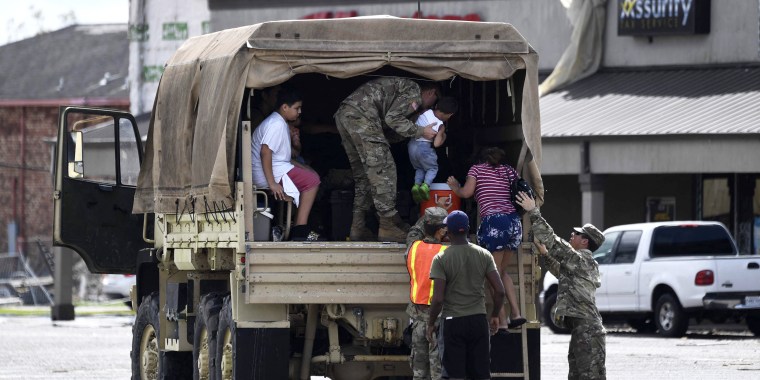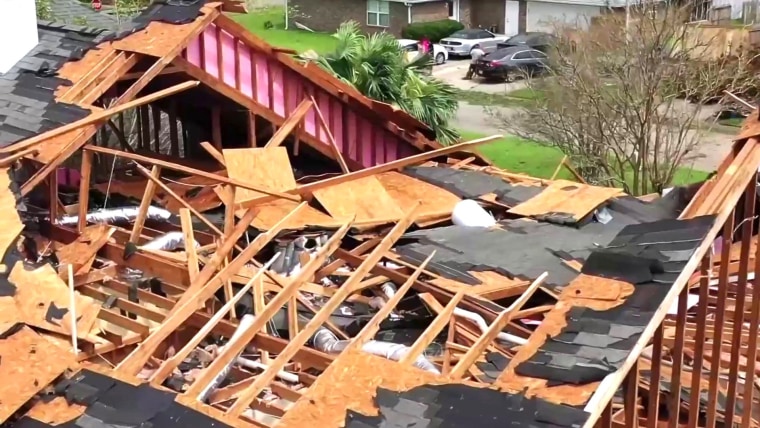NBC News
Power out for more than a million in Louisiana as weakened Ida moves through Mississippi
By Rachel Elbaum and Eric Ortiz August 31, 2021
Video: blob:https://www.nbcnews.com/790fde02-2a33-45f3-b5e2-c27ef4e53807
More than a million homes and businesses remained without power Tuesday after Hurricane Ida tore through Louisiana and Mississippi, bringing with it floods, destruction and the deaths of at least four people.
The powerful storm, now a tropical depression threatening to produce flash flooding and tornadoes across the South and Mid-Atlantic, was one of the strongest hurricanes ever to make landfall in the region. While New Orleans was largely spared the catastrophic flooding that officials had feared, some communities across southern Louisiana remained cut off by water and blocked roadways, complicating rescue efforts as crews scramble to clear debris and begin the weekslong task of restoring electricity.
Louisiana Lt. Gov. Billy Nungesser, who planned to fly out to some of the harder hit areas on Tuesday with Gov. John Bel Edwards, said that the number of deaths could rise.
“Knowing that so many people stayed behind in places like Grand Isle and Lafitte, where flood waters have devastated those areas, we expect there will be more people found that have passed,” he said on NBC’s “TODAY” show.
“Too many people always ride these storms out and take their lives into their hands,” he added.
The latest on Ida:
- Find more up-to-the-minute updates at our live blog.
- Ida, which weakened to a tropical depression, was crawling toward Tennessee on Tuesday about 100 miles southwest of Nashville with 30 mph winds.
- More than 71 million people are under flash flood watches from the Gulf Coast to the Northeast.
- At least four deaths, two in Louisiana and two in Mississippi, were related to the storm.
- More than 1 million homes and businesses remained without power across Louisiana.
Late Monday, two people were killed and 10 were injured after a 50-foot stretch of highway collapsed in George County, Mississippi, an area that had torrential rains in the past 24 hours. Three of the injured were critical, according to Mississippi Highway Patrol Trooper Calvin Robertson. Authorities have not identified the two people who died.
Earlier in the day, at least two deaths in Louisiana were linked to the storm: a 60-year-old man who died in Ascension Parish when a tree fell on his home, and a man who drowned after driving through a flooded road, authorities said.

Another 71-year-old Louisiana man was presumed dead after being attacked by an alligator on Monday in an area that flooded during Hurricane Ida, the St. Tammany Parish Sheriff’s Office said. A woman in Slidell said her husband was walking in floodwaters around noon when he was attacked by the large alligator, the sheriff’s office said.
She said she pulled him to safety and then went to get help in a boat, but when she returned, he was not on the front steps.
The weather system made its way to northern Mississippi early Tuesday, bringing with it heavy rains and the threat of floods from the Gulf Coast to the Tennessee and Ohio valleys and into the Mid-Atlantic on Wednesday, according to the National Hurricane Center. More than 71 million people are under flash flood watches from the Gulf Coast to the Northeast.
August 31, 2021
The hurricane center also warned of the threat of tornadoes across eastern Alabama, western Georgia and the Florida Panhandle. As the remnants of Ida move farther north, major East Coast cities, including Washington, Philadelphia and New York, are expected to receive heavy rainfall and the threat of flash flooding Wednesday and Thursday.
Ida made landfall as a Category 4 storm on Sunday, with howling 150 mph winds on the same date that the devastating Hurricane Katrina struck 16 years earlier.
More than 1 million homes and businesses in Louisiana remained without power for a second day on Tuesday. Entergy, one of the region’s main power utilities, tweeted Monday that it “will likely take days to determine the extent of damage to our power grid … and far longer to restore electrical transmission to the region.”
Officials at Louis Armstrong New Orleans International Airport said that there would be no flights in or out of the city on Tuesday, and there were about 200 canceled flights.
Utility crews were working around the clock to restore power. Nungesser said that some areas will come back on in days, while others will take weeks to get back on the grid.
“The good news is that Louisiana helps our neighbors out,” he said on “TODAY.” “With Covid on top of this, the stress on families is incredible. It’s going to be a long road and we’re going to need a lot of help.”
On Monday, dozens of rescue missions were launched across southern Louisiana to evacuate people stranded in their homes. Operations to answer the hundreds of rescue calls were hampered by inoperable 911 lines, now restored, and poor cellphone service reported throughout southeastern Louisiana.
The Louisiana National Guard activated 4,900 Guard personnel and was positioned to send nearly 200 high-water vehicles and more than 70 rescue boats and 30 helicopters. By Monday afternoon, nearly 200 people and their pets had been rescued after crews checked about 400 homes, Edwards said at a news conference.

New Orleans did not experience the same level of devastation that was caused by Katrina, the 2005 storm that breached the city’s levees and led to some 1,800 deaths.
Mayor LaToya Cantrell tweeted Monday that the system of levees, which was built and designed after Katrina, “held the line” against the storm surge and the “worst case scenario did not happen.”
The new levee system “performed exceptionally well,” Chip Kline, the chairman of the state Coastal Protection and Restoration Authority, told NOLA.com. “The system’s first real test, and it did exceptionally well.”
Louisiana residents who stayed in the area throughout the storm woke up Monday to scenes of destruction. Theophilus Charles, 70, lost the home in Houma his grandmother built to Ida.
“I ain’t got a dry spot in the house. My roof fell. I lost all my clothes, my furniture, my appliances, everything,” he told Reuters.
“I lost everything that I had. I mean I lost everything. And nothing I can do with this, ain’t no repair, you know,” Charles said.
Louisiana’s medical system, already stretched to capacity by the Covid-19 crisis, was another major cause for concern both before and after the storm hit. Four hospitals have evacuated patients, while many others are surveying damage to their buildings.
Dr. Mark Kline, physician-in-chief of Children’s Hospital New Orleans, said Tuesday that the facility was running on six generators dedicated to patient care, while nonessential areas where being left in the dark.
“The best thing I can tell you is that all of the children remained safe and sound inside the hospital throughout the hurricane, and so things are going well for our patients,” Kline said on MSNBC.
The hospital had some flooding on the ground floor as well as water leaking through the roof. Kline said that he, along with much of the hospital’s staff, have yet to go home to survey the damage to their own properties.
Experts are also concerned that the Louisiana’s high levels of circulating coronavirus, coupled with the low vaccination rates and the forced close proximity that occurs during a storm, could set the stage for an explosion of Covid-19 cases.


